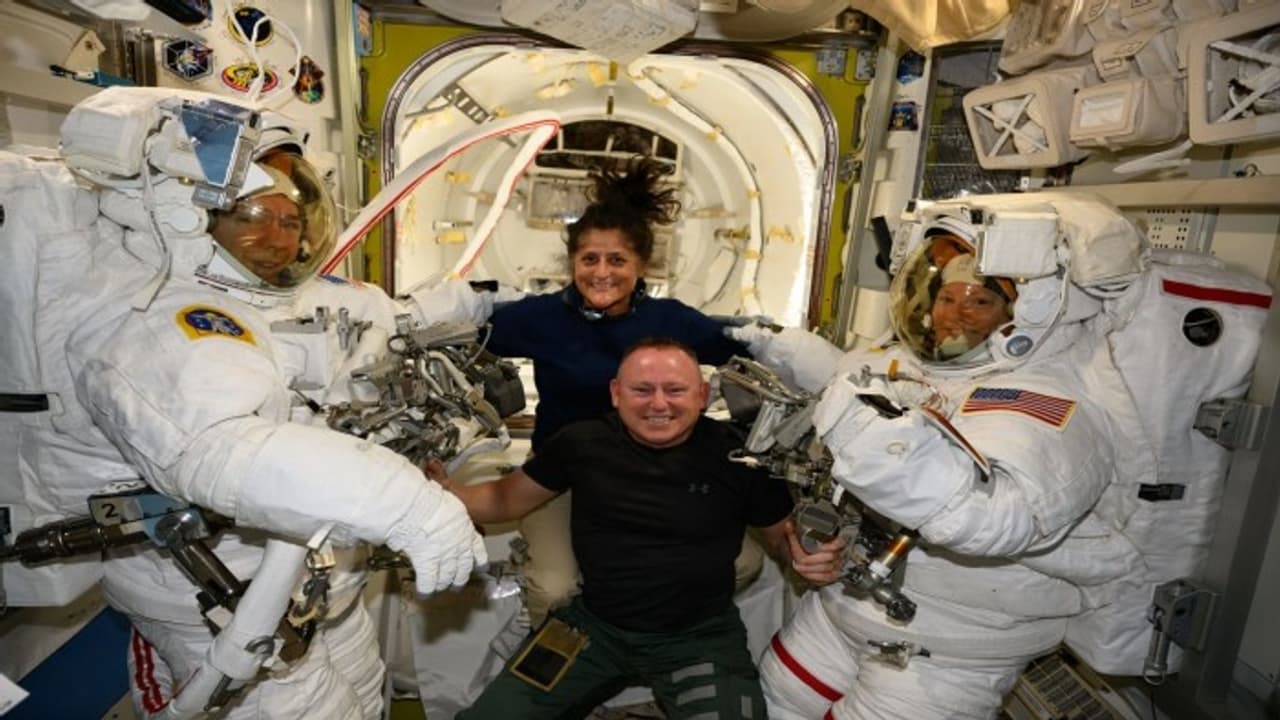Indian-origin astronaut Sunita Williams and her NASA colleague Butch Wilmore, who have been aboard the International Space Station (ISS) since June as part of Nasa's Boeing Crew Flight Test, will now return to Earth with billionaire Elon Musk's SpaceX in February 2025.
Indian-origin astronaut Sunita Williams and her NASA colleague Butch Wilmore who arrived at the International Space Station (ISS) aboard crisis-hit Boeing's Starliner in June, will return home with billionaire Elon Musk's SpaceX next year. The two astronauts were launched to the ISS on June 5 for what was expected to be an eight-day test mission. Their homecoming, however, has been delayed by six more weeks due to thruster malfunctions of the Boeing spacecraft.

NASA on Saturday announced that the two astronauts will return to Earth in February next year. NASA's BoeingSpace Crew Flight Test will return to Earth with an uncrewed Starliner in early September.
“Spaceflight is risky, even at its safest and most routine. A test flight, by nature, is neither safe, nor routine. The decision to keep Butch and Suni aboard the International Space Station and bring Boeing’s Starliner home uncrewed is the result of our commitment to safety: our core value and our North Star,” said NASA Administrator Bill Nelson.
“I’m grateful to both the NASA and Boeing teams for all their incredible and detailed work,” he added.
BOEING'S STARLINER SETBACKS: WHAT EXACTLY HAPPENED?
After years of delays, Boeing's Starliner finally lifted off on June 5 carrying Sunita Williams and Butch Wilmore to the space station. But a day later, on June 6, as Starliner was approaching the ISS, NASA and Boeing identified helium leaks and experienced issues with the spacecraft's reaction control thrusters.
Since then, engineering teams have completed a significant amount of work, including reviewing a collection of data, conducting flight and ground testing, hosting independent reviews with agency propulsion experts, and developing various return contingency plans. The uncertainty and lack of expert concurrence does not meet the agency’s safety and performance requirements for human spaceflight, thus prompting NASA leadership to move the astronauts to the Crew-9 mission.
Five of Starliner's 28 thrusters failed during flight and it sprang several leaks of helium, which is used to pressurize the thrusters. It was still able to dock with the space station, which has housed rotating crews of astronauts for over two decades.
NASA, however, feared the capsule would not be able to achieve the thrust necessary to return to Earth and decided to transfer the two astronauts to a SpaceX mission and return the Starliner empty.
“Decisions like this are never easy, but I want to commend our NASA and Boeing teams for their thorough analysis, transparent discussions, and focus on safety during the Crew Flight Test,” said Ken Bowersox, associate administrator for NASA’s Space Operations Mission Directorate.
“We’ve learned a lot about the spacecraft during its journey to the station and its docked operations. We also will continue to gather more data about Starliner during the uncrewed return and improve the system for future flights to the space station,” he added.
How Elon Musk's SpaceX will help to bring back Sunita Williams, Butch Wilmore to Earth?
In a rare reshuffling of NASA's astronaut operations, Sunita Williams and Butch Willmore will now return to Earth on Elon Musk's SpaceX Crew Dragon spacecraft.
Under the new plan, the SpaceX Crew-9 mission will take off in late September after the Starliner has headed earthward, freeing a docking port on the ISS.
"The uncrewed return allows NASA and Boeing to continue gathering testing data on Starliner during its upcoming flight home, while also not accepting more risk than necessary for its crew," the US space agency, NASA, said.
Why Elon Musk's SpaceX over Boeing?
NASA's decision to select Elon Musk's SpaceX Crew Dragon spacecraft over Boeing to bring astronauts Sunita Williams and Butch Wilmore back to Earth reflects a combination of performance, cost-effectiveness, and innovation.
Peformance and Reliability: SpaceX’s Crew Dragon spacecraft demonstrated superior performance and reliability compared to Boeing’s CST-100 Starliner. Crew Dragon, developed under NASA’s Commercial Crew Program, successfully completed multiple crewed missions to the International Space Station (ISS), showcasing its ability to safely transport astronauts to and from orbit. Its reliability was further cemented during its test flights, where it passed rigorous safety and performance evaluations. In contrast, Boeing’s Starliner experienced several delays and issues during its test flights. For instance, a 2019 uncrewed test flight suffered from software and timing errors that prevented it from docking with the ISS, and while Boeing made improvements, these issues raised concerns about its readiness.
Cost-effectiveness: SpaceX’s approach offered a more economical solution compared to Boeing. SpaceX’s Crew Dragon missions were generally less expensive, partly due to the company’s innovative reuse of Falcon 9 rockets and the streamlined manufacturing processes of its spacecraft. SpaceX’s proven ability to deliver high performance at a lower cost made it an attractive option for NASA’s needs, allowing the agency to maximize its resources while ensuring safe astronaut returns.
Schedule adherence: Timeliness was another significant factor. SpaceX had a track record of adhering to schedules and delivering on its commitments. NASA needed a reliable partner that could meet the tight schedules required for ISS missions, and SpaceX’s consistent performance and timely delivery played a crucial role in their selection. Boeing, on the other hand, faced delays that affected its ability to meet mission timelines.
